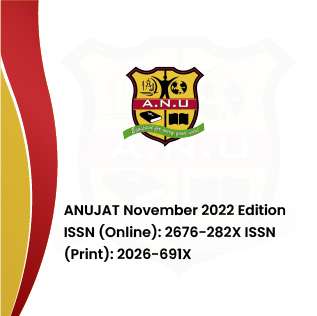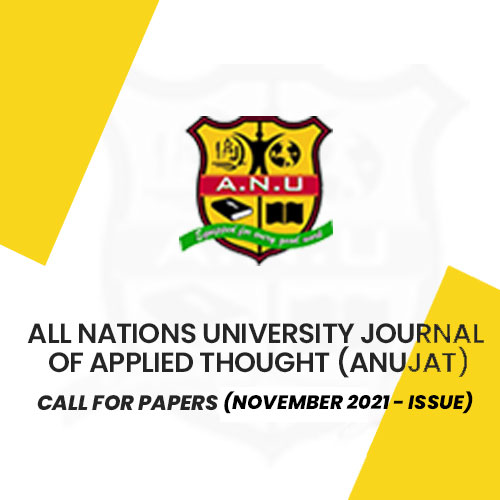Peer reviewers
The journal will employ the double-blind peer review process, where both reviewers and authors remain anonymous throughout the review process. All research articles will be submitted to two anonymous experts.
Every proposal submitted for publication is read at least by the editor, for an initial review. If the paper agrees with editorial policies and with a minimum quality level, is sent to two reviewers. Editor will provide a list of relevant academics with expertise in the field and will choose two reviewers from this list. Each manuscript is reviewed by at least two reviewers. The reviewers act independently and they are not aware of each other’s identities. The reviewers are selected solely according to whether they have the relevant expertise for evaluating a manuscript. They must not be from the same institution as the author(s) of the manuscript, nor be their co-authors in the recent past. No suggestions of individual reviewers by the author(s) of the manuscript will be accepted.
The reviewers will not know the author’s identity, as any identifying information will be stripped from the document before review. Reviewers’ comments to the editors are confidential and before passing on to the author is made anonymous.
Peer reviewers will have four possible options for each article:
[1] Accept without revision.
[2] Accept with minor amendments.
[3] Support publication with major revisions and likely re-review.
[4] Reject.
In cases where there is strong disagreement either among peer reviewers, further expert advice may be sought.
Based on the reviewers’ comments, the Editor will make a final decision on the acceptability of the manuscript, and communicates to the authors the decision, along with reviewers’ reports. Whether significant revisions are proposed, acceptance is dependent on whether the author can deal with those satisfactorily.
The purpose of peer review is to assists the Editorial Board in making decision of whether to accept or reject a paper. The purpose is also to assist the author in improving papers.
Peer Review Process
Manuscripts are sent for review only if they pass the initial evaluation regarding their form and thematic scope. A special care is taken that the initial evaluation does not last more than necessary.
Under normal circumstances, the review process takes up to four weeks, and only exceptionally up to two months. The total period from the submission of a manuscript until its publication takes an average of 45 days.
During the review process the Editor-in-Chief and Managing Editor may require authors to provide additional information (including raw data) if they are necessary for the evaluation of the manuscript. These materials shall be kept confidential and must not be used for any other purposes.
The entire review process takes place under the supervision of the Editor-in-Chief and Managing Editor in an online environment. The system also allows authors to track the entire process of reviewing the manuscript.
Resolving Inconsistences
In the case that the authors have serious and reasonable objections to the reviews, the Editorial Board makes an assessment of whether a review is objective and whether it meets academic standards. If there is a doubt about the objectivity or quality of review, the Editor-in-Chief and Managing Editor will assign additional reviewer(s). Additional reviewers may also be assigned when reviewers’ decisions (accept or reject) are contrary to each other or otherwise substantially incompatible.
The final decision on the acceptance of the manuscript for publication rests solely with the Editor-in-Chief and Managing Editor.
Responsibilities
Editorial Responsibilities
Decision on the Publication of Article
The Chief Editor and Managing Editor are responsible for deciding which of the articles accepted for publication after undergoing double blind peer review should be published. The Chief Editor and the Managing Editor may be guided by the policies of the journal’s Editorial Board and subjected to such legal requirements regarding libel, copyright infringement and plagiarism. However, neither the Chief Editor nor the Managing Editor have the authority to influence the reviewers who are conducting the blind review of the articles submitted for peer review.
- The Editor-in-Chief is responsible for deciding which articles submitted to the journal will be published. The decisions are made based exclusively on the manuscript’s merit. They must be free from any racial, gender, sexual, religious, ethnic, or political bias. When making decisions the Editor-in-Chief is also guided by the editorial policy and legal provisions relating to defamation, copyright infringement and plagiarism.
- Members of the Editorial Board including the Editor-in-Chief must hold no conflict of interest with regard to the articles they consider for publication. Members who feel they might be perceived as being involved in such a conflict do not participate in the decision process for a particular manuscript.
- The information and ideas presented in submitted manuscripts shall be kept confidential. Information and ideas contained in unpublished materials must not be used for personal gain without the written consent of the authors.
- Editors and the editorial staff shall take all reasonable measures to ensure that the authors/reviewers remain anonymous during and after the evaluation process in accordance with the type of reviewing in use.
- The Editorial Board is obliged to assist reviewers with additional information on the manuscript, including the results of checking manuscript for plagiarism.
- Fair Play: Manuscripts shall be evaluated solely on their intellectual merit without regard to authors’ race, gender, sexual orientation, religious beliefs, ethnic origin, citizenship, or political philosophy.
- Confidentiality: The Chief Editor, the Managing Editor and any editorial staff must not disclose any information about a submitted manuscript to anyone other than the corresponding author, reviewers, potential reviewers, other editorial advisers, and the publisher
- Disclosure and Conflicts of Interest: Unpublished materials disclosed in a submitted manuscript must not be used by anyone who has a view of the manuscript (while handling it) in his or her own research without the express written consent of the author
Reviewers’ Responsibilities
Contribution of Double Blind Peer Review
Double Blind Peer review assists the reviewers in making editorial decisions, while editorial communications with the author may also assist the author in improving the paper. The reviewers don’t know the author’s identity, as any identifying information will be stripped from the document before review. Reviewers’ comments to the editors are confidential and before passing on to the author will be made anonymous. The names of the reviewers remain strictly confidential; with their identities known only the Chief Editor and the Managing Editor.
- Reviewers are required to provide the qualified and timely assessment of the scholarly merits of the manuscript. The reviewer takes special care of the real contribution and originality of the manuscript. The review must be fully objective. The judgment of the reviewers must be clear and substantiated by arguments.
- The reviewers assess manuscript for the compliance with the profile of the journal, the relevance of the investigated topic and applied methods, the scientific relevance of information presented in the manuscript, the presentation style and scholarly apparatus. The review has a standard format. It is submitted through email (anujat.edu.gh/[email protected]) or the online ANUJAT webpage where it is stored permanently.
- The reviewer must not be in a conflict of interest with the authors or funders of research. If such a conflict exists, the reviewer is obliged to promptly notify the Editor-in-Chief. The reviewer shall not accept for reviewing papers beyond the field of his/her full competence.
- Reviewers should alert the Editor-in-Chief to any well-founded suspicions or the knowledge of possible violations of ethical standards by the authors. Reviewers should recognize relevant published works that have not been considered in the manuscript. They may recommend specific references for citation, but shall not require to cite papers published in ANUJAT or their own papers, unless it is justified.
- The reviewers are expected to improve the quality of the manuscript through their suggestions. If they recommend correction of the manuscript prior to publication, they are obliged to specify the manner in which this can be achieved.
- Any manuscripts received for review must be treated as confidential documents. Reviewers must not use unpublished materials disclosed in submitted manuscripts without the express written consent of the authors.
- Promptness: Any selected referee who feels unqualified to review the assigned manuscript or unable to provide a prompt review should notify the Chief Editor and the Managing Editor and excuse himself/herself from the review process.
- Confidentiality: Manuscripts received for review must be treated as confidential documents. They must not be shown to, or discussed with, others except as authorized by the Chief Editor and the Managing Editor. Privileged information or ideas obtained through double blind peer review must be kept confidential and not used for personal advantage.
- Standards of Objectivity: Reviews should be conducted objectively. There shall be no personal criticism of the author. Reviewers should express their views clearly with supporting arguments.
- Acknowledgment of Sources: Reviewers should identify relevant published work that has not been cited by the authors. Any statement that had been previously reported elsewhere should be accompanied by the relevant citation. A reviewer should also call to the Chief Editor/Managing Editor’s attention any substantial similarity or overlap between the manuscript under consideration and any other published paper of which they have personal knowledge.
- Conflict of Interest: Reviewers should not review manuscripts in which they have conflicts of interest resulting from competitive, collaborative, or other relationships or connections with any of the authors, companies, or institutions connected to the papers
Authors’ Responsibilities
- Authors warrant that their manuscripts are their original works, that they have not been published before, and are not under consideration for publication elsewhere. Parallel submission of the same paper to another journal constitutes a misconduct and eliminates the manuscript from further consideration. The work that has already been published elsewhere cannot be reprinted in ANUJAT.
- Authors are exclusively responsible for the contents of their submissions. Authors affirm that the article contains no unfounded or unlawful statements and does not violate the rights of third parties.
- Authors must make sure that their author team listed in the manuscript includes all and only those authors who have significantly contributed to the submitted manuscript. If persons other than authors were involved in important aspects of the research project and the preparation of the manuscript, their contribution should be acknowledged in a footnote or the Acknowledgments section.
- It is the responsibility of the authors to specify the title and code label of the research project within which the work was created, as well as the full title of the funding institution. In case a submitted manuscript has been presented at a conference in the form of an oral presentation (under the same or similar title), detailed information about the conference shall be provided in the same place.
- Authors are required to properly cite sources that have significantly influenced their research and their manuscript. Parts of the manuscript, including text, equations, pictures and tables that are taken verbatim from other works must be clearly marked, e.g. by quotation marks accompanied by their location in the original document (page number), or, if more extensive, given in a separate paragraph.
- Full references of each quotation (in-text citation) must be listed in the separate section (Literature or References) in a uniform manner, according to the citation style used by the journal. References section should list only quoted/cited, and not all sources used for the preparation of a manuscript.
- When authors discover a significant error or inaccuracy in their own published work, it is their obligation to promptly notify the Editor-in-Chief or Managing Editor (or publisher) and cooperate with him/her to retract or correct the paper.
- Authors should disclose in their manuscript any financial or other substantive conflict of interest that might have influenced the presented results or their interpretation.
- By submitting a manuscript, the authors agree to abide by the Editorial Policies of ANUJAT.
- Reporting Standards: Authors of reports of original research should present an accurate account of the work performed as well as an objective discussion of its significance. Underlying data should be represented accurately in the paper. A paper should contain sufficient detail and references to permit others to replicate the work. Fraudulent or knowingly inaccurate statements constitute unethical behaviour and are unacceptable.
- Data Access and Retention: Authors may be asked to provide the raw data in connection with a paper for editorial review, and should be prepared to provide public access to such, if practicable, and should in any event, be prepared to retain such data for a reasonable time after publication.
- Originality and Plagiarism: Authors should ensure that they have written entirely original works, and if the authors have used the work and/or words of others, this must be appropriately cited or quoted. All ANUJAT publications are committed to publishing only original material, i.e., material that has neither been published elsewhere, nor is under review elsewhere. Manuscripts that are found to have been plagiarized from a manuscript by other authors, whether published or unpublished, will incur plagiarism sanctions.
- Multiple Publications: An author should not in general publish manuscripts describing essentially the same research in more than one journal or primary publication. Submitting the same manuscript to more than one journal concurrently constitutes unethical publishing behaviour and is unacceptable.
- Duplicate Submission: Manuscripts that are found to have been published elsewhere, or to be under review elsewhere, will incur duplicate submission/publication sanctions. If authors have used their own previously published work, or work that is currently under review, as the basis for a submitted manuscript, they are required to cite the previous work and indicate how their submitted manuscript offers novel contributions beyond those of the previous work.
- Acknowledgment of Sources: Proper acknowledgment of the work of others must always be given. Authors should cite publications that have been influential in determining the nature of the reported work.
- Citation Manipulation: Submitted manuscripts that are found to include citations whose primary purpose is to increase the number of citations to a given author’s work, or to articles published in a particular journal, will incur citation manipulation sanctions.
- Data Fabrication and Falsification: Submitted manuscripts that are found to have either fabricated or falsified experimental results, including the manipulation of images, will incur data fabrication and falsification sanctions.
- Authorship of the Paper: Authorship should be limited to those who have made a significant contribution to the conception, design, execution, or interpretation of the reported study. All those who have made significant contributions should be listed as co-authors. Where there are others who have participated in certain substantive aspects of the research project, they should be acknowledged or listed as contributors.
- Improper Author Contribution or Attribution: All listed authors must have made a significant scientific contribution to the research in the manuscript and approved all its claims. It is important to list everyone who made a significant scientific contribution, including students and laboratory technicians.
- The Corresponding Author: The Corresponding Author is the author responsible for communicating with the journal for publication. The corresponding author should ensure that all appropriate co-authors and no inappropriate co-authors are included on the paper, and that all co-authors have seen and approved the final version of the paper and have agreed to its submission for publication.
- Acknowledgment of Funding Sources: Sources of funding for the research reported in the article should be duly acknowledged at the end of the article.
- Disclosure and Conflicts of Interest: All authors should disclose in their manuscript any financial or other substantive conflict of interest that might be construed to influence the results or interpretation of their manuscript. All sources of financial support for the project should be disclosed.
- Fundamental Errors in Published Works: When an author discovers a significant error or inaccuracy in his/her own published work, it is the author’s obligation to promptly notify the Chief Editor/Managing Editor and cooperate with the editors to retract or correct the paper.
- Redundant Publications: Redundant publications involve the inappropriate division of study outcomes into several articles




